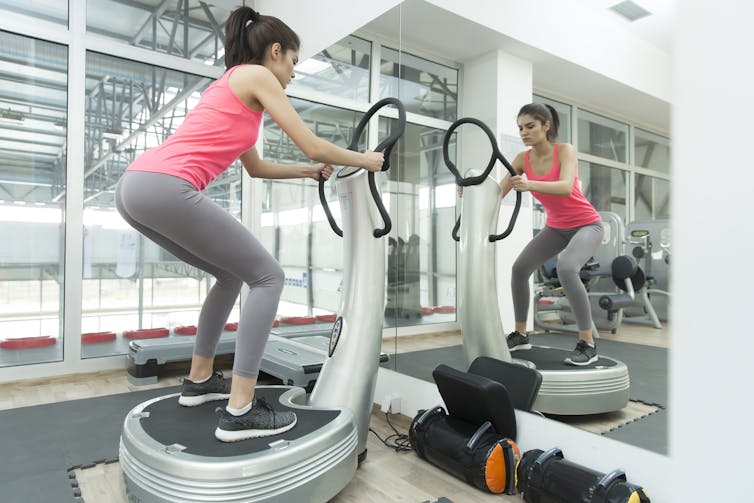Alliance Images/ Shutterstock
As we get older, many of us find we can’t walk or move the way we used to. While this can be partly explained as an inevitable symptom of ageing, a range of diseases – including Parkinson’s disease, sarcopenia and osteoporosis – can also make it more difficult for us to move.
Rather paradoxically, people with these conditions are often told they should exercise as it can strengthen their muscles and bones. But for someone who already finds movement difficult, getting the amount of exercise needed to see improvements will be hard. So researchers have turned to a slightly more unconventional solution – which might be as simple as standing on a vibrating platform.
Whole-body vibration training involves standing, sitting or even lying on a machine with a vibrating platform. While the person performs different strength or balancing exercises, the machine delivers vibrations at different frequencies, typically ranging from 10-40Hz.
While the platform vibrates, it stimulates the muscle fibres, causing them to contract and relax – sometimes up to 60 times a second. This makes the exercise the person is performing more effective.
The reason whole-body vibration training is gaining interest is because it’s easier to do than regular exercise. This means even people who can’t exercise normally can still get similar benefits as they would from exercising. And for people who do exercise regularly, it could provide additional health benefits – including improved strength and stability.
It’s thought that whole-body vibration training can improve physical function for many of the same reasons exercise does. Research shows it can improve muscle and bone quality, increase bone mineral density and even improve communication between our muscles and nervous system. Together, these changes make bones and muscles stronger and more efficient. This may reduce the risk of falls and fractures, and may even prevent diseases, such as sarcopenia, from developing.
Improving physical function
Researchers are currently looking at whole-body vibration training to improve physical function for several conditions.
For example, research shows that including whole-body vibration training into your regular exercise routine can help improve physical function if it has declined due to ageing. Even in people who didn’t regularly exercise, doing whole-body vibration training for 15 minutes three times a week improved physical function and decreased frailty compared with those who did not. These improvements were even seen for up to 12 months after the study ended – while physical function continued to decrease for the participants who didn’t do whole-body vibration training.
Whole-body vibration training may also help people with neurological conditions that affect movement – such as Parkinson’s disease, multiple sclerosis, stroke and spinal cord injury.

BGStock72/ Shutterstock
It’s thought that because whole-body vibration training increases neuromuscular activation, it strengthens the connections between our muscles and our brain. This allows them to communicate more efficiently. Motor function and proprioception (the body’s ability to sense movement) may improve as a result.
Whole-body vibration training may also be useful in preventing or improving osteoporosis. The vibrations generate an electrical charge in our bones that may help increase bone mineral density – and even help form new bone cells. This all works together to improve muscle strength and physical function.
But not all studies agree that whole-body vibration training has any effect on osteoporosis – suggesting more research will be needed to see if it can indeed improve musculoskeletal health.
Training limitations
Although whole-body vibration training has a lot of potential, it has several limitations to consider.
No studies have shown whole-body vibration training to have any negative effects, so it is largely believed to be safe. However, it’s recommended that people with a pacemaker, those who are pregnant or have a broken bone and people with hip and knee replacements avoid whole-body vibration training.
There is also limited evidence at the moment of the effect of long-term, repeated use of whole-body vibration training – especially when done at high frequencies above 90Hz. We know from research on people who are exposed to severe vibrations for extended periods (such as construction workers) that they may experience blood vessel, neurological, and musculoskeletal problems, such as back pain. So it will be important to continue looking at the safety of high-frequency, long-term, whole-body vibration training. But as most training sessions are short and done at frequencies lower than 90Hz, it’s likely to be safe during typical use.
Another limitation of whole-body vibration training is simply that it isn’t used as often as it should be. This may be because healthcare professionals are not aware of its benefits, or because people do not have access to a machine.
It should also be said that whole-body vibration training is not designed to replace traditional exercise in healthy people. But for people who find exercise difficult – especially if it’s because they’re less able to move – whole-body vibration training can provide similar benefits as exercise. Current research suggests that doing 15 minutes of whole-body vibration training three times a week for over six weeks is enough to see improvements in physical function for everybody.
![]()
The authors do not work for, consult, own shares in or receive funding from any company or organization that would benefit from this article, and have disclosed no relevant affiliations beyond their academic appointment.











